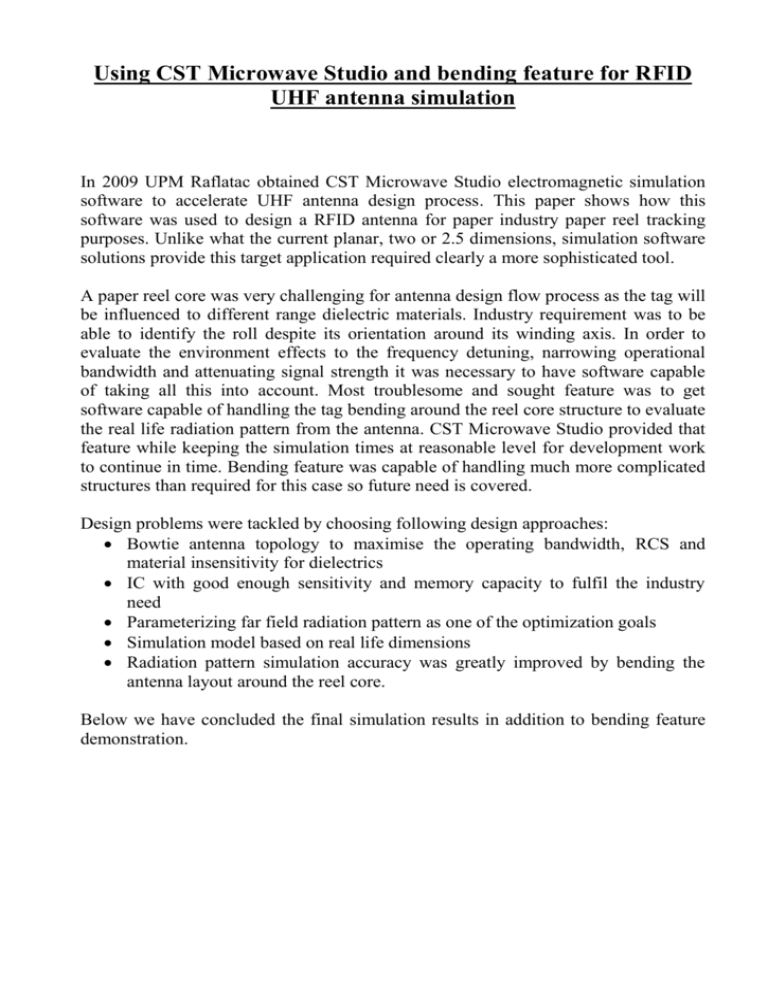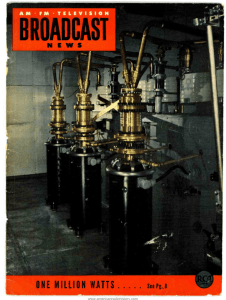Using CST Microwave Studio and bending feature in RFID antenna
advertisement

Using CST Microwave Studio and bending feature for RFID UHF antenna simulation In 2009 UPM Raflatac obtained CST Microwave Studio electromagnetic simulation software to accelerate UHF antenna design process. This paper shows how this software was used to design a RFID antenna for paper industry paper reel tracking purposes. Unlike what the current planar, two or 2.5 dimensions, simulation software solutions provide this target application required clearly a more sophisticated tool. A paper reel core was very challenging for antenna design flow process as the tag will be influenced to different range dielectric materials. Industry requirement was to be able to identify the roll despite its orientation around its winding axis. In order to evaluate the environment effects to the frequency detuning, narrowing operational bandwidth and attenuating signal strength it was necessary to have software capable of taking all this into account. Most troublesome and sought feature was to get software capable of handling the tag bending around the reel core structure to evaluate the real life radiation pattern from the antenna. CST Microwave Studio provided that feature while keeping the simulation times at reasonable level for development work to continue in time. Bending feature was capable of handling much more complicated structures than required for this case so future need is covered. Design problems were tackled by choosing following design approaches: Bowtie antenna topology to maximise the operating bandwidth, RCS and material insensitivity for dielectrics IC with good enough sensitivity and memory capacity to fulfil the industry need Parameterizing far field radiation pattern as one of the optimization goals Simulation model based on real life dimensions Radiation pattern simulation accuracy was greatly improved by bending the antenna layout around the reel core. Below we have concluded the final simulation results in addition to bending feature demonstration. Fig 1. Fig 2. Fig 3. Fig 4. Fig 5. Fig 6. Fig 7. Fig 8. Fig 7 above shows the 2D presentation of the radiation pattern. Direction of the main lobe is 107 degrees and the width of the - 3dB beam 193 degrees accordingly. Fig 8 shows the 3D radiation pattern with lobe maximum around the winding axis. Radiation minimum is directed to 180 degrees which is through the core twice and once through the paper. Fig 1. – Simulation model of the paper roll including the core, antenna surface material and the IC. Fig 2. – S11 magnitude (dB) response from the design studio as a function of frequency. Fig 3. – Smith chart diagram Fig 4. – Broadband realised gain of the antenna Fig 5. – Surface current density @ 900 MHz Fig 6. – Closer view on current density near the shortcut loop @ 900 MHz







